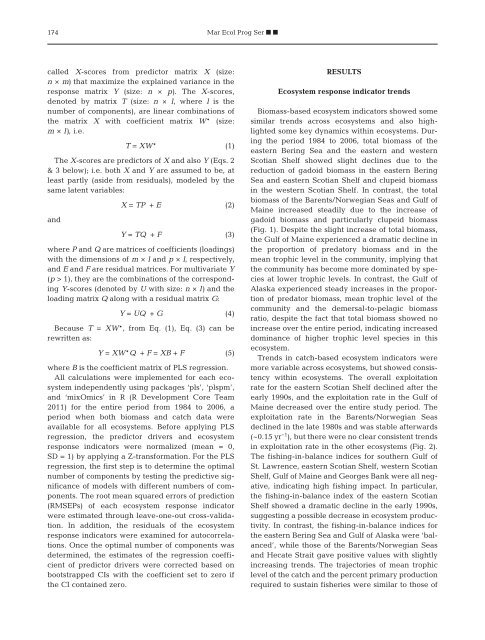Complete Theme Section in pdf format - Inter Research
Complete Theme Section in pdf format - Inter Research
Complete Theme Section in pdf format - Inter Research
Create successful ePaper yourself
Turn your PDF publications into a flip-book with our unique Google optimized e-Paper software.
174<br />
Mar Ecol Prog Ser n n<br />
called X-scores from predictor matrix X (size:<br />
n × m) that maximize the expla<strong>in</strong>ed variance <strong>in</strong> the<br />
response matrix Y (size: n × p). The X-scores,<br />
denoted by matrix T (size: n × l, where l is the<br />
number of components), are l<strong>in</strong>ear comb<strong>in</strong>ations of<br />
the matrix X with coefficient matrix W* (size:<br />
m × l), i.e.<br />
T = XW* (1)<br />
The X-scores are predictors of X and also Y (Eqs. 2<br />
& 3 below); i.e. both X and Y are assumed to be, at<br />
least partly (aside from residuals), modeled by the<br />
same latent variables:<br />
and<br />
X = TP + E (2)<br />
Y = TQ + F (3)<br />
where P and Q are matrices of coefficients (load<strong>in</strong>gs)<br />
with the dimensions of m × l and p × l, respectively,<br />
and E and F are residual matrices. For multivariate Y<br />
(p > 1), they are the comb<strong>in</strong>ations of the correspond<strong>in</strong>g<br />
Y-scores (denoted by U with size: n × l) and the<br />
load<strong>in</strong>g matrix Q along with a residual matrix G:<br />
Y = UQ + G (4)<br />
Because T = XW*, from Eq. (1), Eq. (3) can be<br />
rewritten as:<br />
Y = XW*Q + F = XB + F (5)<br />
where B is the coefficient matrix of PLS regression.<br />
All calculations were implemented for each ecosystem<br />
<strong>in</strong>dependently us<strong>in</strong>g packages ‘pls’, ‘plspm’,<br />
and ‘mixOmics’ <strong>in</strong> R (R Development Core Team<br />
2011) for the entire period from 1984 to 2006, a<br />
period when both biomass and catch data were<br />
available for all ecosystems. Before apply<strong>in</strong>g PLS<br />
regression, the predictor drivers and ecosystem<br />
response <strong>in</strong>dicators were normalized (mean = 0,<br />
SD = 1) by apply<strong>in</strong>g a Z-trans<strong>format</strong>ion. For the PLS<br />
regression, the first step is to determ<strong>in</strong>e the optimal<br />
number of components by test<strong>in</strong>g the predictive significance<br />
of models with different numbers of components.<br />
The root mean squared errors of prediction<br />
(RMSEPs) of each ecosystem response <strong>in</strong>dicator<br />
were estimated through leave-one-out cross-validation.<br />
In addition, the residuals of the ecosystem<br />
response <strong>in</strong>dicators were exam<strong>in</strong>ed for autocorrelations.<br />
Once the optimal number of components was<br />
determ<strong>in</strong>ed, the estimates of the regression coefficient<br />
of predictor drivers were corrected based on<br />
bootstrapped CIs with the coefficient set to zero if<br />
the CI conta<strong>in</strong>ed zero.<br />
RESULTS<br />
Ecosystem response <strong>in</strong>dicator trends<br />
Biomass-based ecosystem <strong>in</strong>dicators showed some<br />
similar trends across ecosystems and also highlighted<br />
some key dynamics with<strong>in</strong> ecosystems. Dur<strong>in</strong>g<br />
the period 1984 to 2006, total biomass of the<br />
eastern Ber<strong>in</strong>g Sea and the eastern and western<br />
Scotian Shelf showed slight decl<strong>in</strong>es due to the<br />
reduction of gadoid biomass <strong>in</strong> the eastern Ber<strong>in</strong>g<br />
Sea and eastern Scotian Shelf and clupeid biomass<br />
<strong>in</strong> the western Scotian Shelf. In contrast, the total<br />
biomass of the Barents/Norwegian Seas and Gulf of<br />
Ma<strong>in</strong>e <strong>in</strong> creased steadily due to the <strong>in</strong>crease of<br />
gadoid biomass and particularly clupeid biomass<br />
(Fig. 1). Despite the slight <strong>in</strong>crease of total biomass,<br />
the Gulf of Ma<strong>in</strong>e experienced a dramatic decl<strong>in</strong>e <strong>in</strong><br />
the proportion of predatory biomass and <strong>in</strong> the<br />
mean trophic level <strong>in</strong> the community, imply<strong>in</strong>g that<br />
the community has become more dom<strong>in</strong>ated by species<br />
at lower trophic levels. In contrast, the Gulf of<br />
Alaska experienced steady <strong>in</strong>creases <strong>in</strong> the proportion<br />
of predator biomass, mean trophic level of the<br />
community and the demersal-to-pelagic biomass<br />
ratio, despite the fact that total biomass showed no<br />
<strong>in</strong>crease over the entire period, <strong>in</strong>dicat<strong>in</strong>g <strong>in</strong>creased<br />
dom<strong>in</strong>ance of higher trophic level species <strong>in</strong> this<br />
ecosystem.<br />
Trends <strong>in</strong> catch-based ecosystem <strong>in</strong>dicators were<br />
more variable across ecosystems, but showed consistency<br />
with<strong>in</strong> ecosystems. The overall exploitation<br />
rate for the eastern Scotian Shelf decl<strong>in</strong>ed after the<br />
early 1990s, and the exploitation rate <strong>in</strong> the Gulf of<br />
Ma<strong>in</strong>e decreased over the entire study period. The<br />
exploitation rate <strong>in</strong> the Barents/Norwegian Seas<br />
decl<strong>in</strong>ed <strong>in</strong> the late 1980s and was stable afterwards<br />
(~0.15 yr −1 ), but there were no clear consistent trends<br />
<strong>in</strong> exploitation rate <strong>in</strong> the other ecosystems (Fig. 2).<br />
The fish<strong>in</strong>g-<strong>in</strong>-balance <strong>in</strong>dices for southern Gulf of<br />
St. Lawrence, eastern Scotian Shelf, western Scotian<br />
Shelf, Gulf of Ma<strong>in</strong>e and Georges Bank were all negative,<br />
<strong>in</strong>dicat<strong>in</strong>g high fish<strong>in</strong>g impact. In particular,<br />
the fish<strong>in</strong>g-<strong>in</strong>-balance <strong>in</strong>dex of the eastern Scotian<br />
Shelf showed a dramatic decl<strong>in</strong>e <strong>in</strong> the early 1990s,<br />
suggest<strong>in</strong>g a possible decrease <strong>in</strong> ecosystem productivity.<br />
In contrast, the fish<strong>in</strong>g-<strong>in</strong>-balance <strong>in</strong>dices for<br />
the eastern Ber<strong>in</strong>g Sea and Gulf of Alaska were ‘balanced’,<br />
while those of the Barents/Norwegian Seas<br />
and Hecate Strait gave positive values with slightly<br />
<strong>in</strong>creas<strong>in</strong>g trends. The trajectories of mean trophic<br />
level of the catch and the percent primary production<br />
required to susta<strong>in</strong> fisheries were similar to those of
















